Topics covered in this volume (large deviations, differential geometry, asymptotic expansions, central limit theorems) give a full picture of the current advances in the application of asymptotic methods in mathematical finance, and thereby provide rigorous solutions to important mathematical and financial issues, such as implied volatility asymptotics, local volatility extrapolation, systemic risk and volatility estimation. This volume gathers together ground-breaking results in this field by some of its leading experts.
Over the past decade, asymptotic methods have played an increasingly important role in the study of the behaviour of (financial) models. These methods provide a useful alternative to numerical methods in settings where the latter may lose accuracy (in extremes such as small and large strikes, and small maturities), and lead to a clearer understanding of the behaviour of models, and of the influence of parameters on this behaviour.
Graduate students, researchers and practitioners will find this book very useful, and the diversity of topics will appeal to people from mathematical finance, probability theory and differential geometry.
